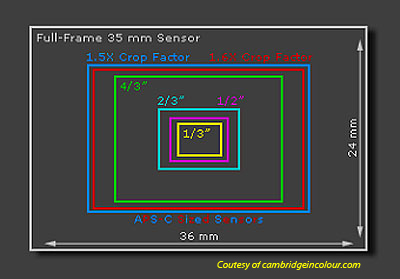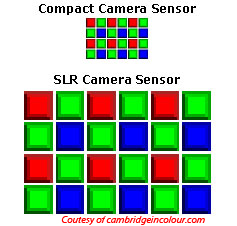The Digital Sensor: A Guide to Understanding Digital Cameras
by Wesley Fink on April 21, 2008 1:00 AM EST- Posted in
- Digital Camera
Sensors Today
| Sensor Size (mm) | ||
| Type | Width | Height |
| 1/3.6" | 4.00 | 3.00 |
| 1/3.2" | 4.54 | 3.42 |
| 1/3" | 4.80 | 3.60 |
| 1/2.7" | 5.37 | 4.03 |
| 1/2.5" | 5.76 | 4.29 |
| 1/2" | 6.40 | 4.80 |
| 1/1.8" | 7.18 | 5.32 |
| 1/1.7" | 7.60 | 5.70 |
| 2/3" | 8.80 | 6.60 |
| 1" | 12.80 | 9.60 |
| 4/3" | 18.00 | 13.50 |
| APS C | 23.70 | 15.70 |
| 35mm film | 36.00 | 24.00 |
In the above chart, the sensor sizes for today's DSLR cameras are in the range of 4/3" and APS C. A few top pro cameras now sport 35mm-size sensors and are referred to as full frame. Comparing this to Compact or Point and Shoot cameras today we generally find a 1/2.3" to 1/2.5" sensor. A few top-of-the-line compact cameras, like the Canon G9, feature a 1/1.8" to 1/1.7" sensor. To see the difference in the relative size of P&S sensors and DSLR sensors, look at the graphic below.

The very best compact cameras have sensors around the 1/3" to 1/2" range. The APS C to 4/3 sensors of the bulk of today's digital SLR cameras are huge by comparison. The developing push for full-frame at the top of the current DSLR market is a move to a sensor that is a bit more than double the size of today's APS C sensors. The approximate 24mm by 16mm APS C is the same size as the 1/2 frame 35mm championed by Olympus in the film era.
This size actually harkens back to 35mm motion picture film that became the standard on which most of the SLR lens systems are based. 35mm motion picture film contained images of around 24x16mm, and 35mm still film just turned the spool direction and used double the frame size. In fact, some early 35mm still cameras were referred to as "double-frame" cameras.
Why Does Sensor Size Matter?
In some of life's arenas bigger is better, but in computers and electronics we almost always see a trend toward smaller and smaller traces producing chips with higher and higher densities. So the question becomes why is a 10MP DSLR sensor any better than a 10MP Compact or Point and Shoot sensor?
The simple answer is that computer chips are digital devices, made up of transistors that register on and off (1 and 0) states, which are then combined to create the information we crunch in a computer. Digital sensors, on the other hand, are analog devices used to gather light and color information. Every digital camera then has some means to convert this analog sensor data to digital information in its processing path. Devices that communicate on and off do not require the sensitivity of devices that gather and convey more complex data like a digital sensor pixel.

Unlike digital data, all pixels are not created equal. Larger sensors, such as those used in digital SLR cameras, have larger pixels. All things being equal the larger pixels have more light-gathering ability over a given unit of time. This translates into two very important considerations for photography.
First, larger pixels exhibit lower noise than smaller pixels under the same conditions. This improved signal-to-noise ratio means that your 10MP DSLR image will likely produce better, sharper, clearer prints than the smaller 10MP compact (point and shoot) cameras. This improved SNR also means larger sensors produce a wider dynamic range (a greater range between the lightest and darkest elements of the photo).
The second aspect also relates to light gathering ability. Large DSLR sensors have more ability to gather light, which means they generally are more effective over a much wider range of lighting conditions than a compact camera. Many compact cameras are perfectly acceptable at ISO 100 but are very noisy by ISO 400. Most DSLR cameras with their larger sensors produce very acceptable results to ISO 800 or 1600 - ISO options not even available on most compact cameras. Some newer DSLR cameras even offer options of ISO 3200, ISO 6400, or even higher.










72 Comments
View All Comments
andrewln - Monday, April 21, 2008 - link
This was followed in about 6 months by the introduction of the Samsung 14.6MP CMOS sensor in the Pentax D20.should be Pentax K20D
Wesley Fink - Monday, April 21, 2008 - link
Typo corrected. Unfortunately spell check can't catch model numbers that are misstated.araczynski - Monday, April 21, 2008 - link
now i know what pc tech illiterate people feel like :)its a good thing i don't care about photography, interesting read none the less.
finbarqs - Monday, April 21, 2008 - link
the thing is, I've read the reviews and saw the comparisons between the 5D and the D200 (I believe that was the last CCD sensor that Nikon used). The 5D has way better per-pixel sharpness than the D200. Perhaps the technology of the CMOS made it so it finally "looks" better than the CCD. Or at least on the Canon side of things. I'm not biased towards any camera. I've own an XTi, 5D, Panasonic DMC-L1, and now a D300. I'm hoping to own the next 5D MKII (or whatever they call it).Even the D2X used a CMOS sensor, and I thought Nikon made the D300 sensor, as well as the D3 sensor (FF). What I also find "funny" is that Sony doesn't have a FF sensor yet, but nikon does, thus leaving me to believe that Nikon came up with their own FF sensor.
melgross - Monday, April 21, 2008 - link
It's Nikon's own design, though I don't remember who makes it.haplo602 - Monday, April 21, 2008 - link
Nice article Wesley, finaly one Anandtech photo related article I enjoyed reading.On note on the growing megapixel count. Sooner more than later, DSLR in APS-C (and later full frame ones) will hit the same technology wall P&S are facing (too small photosite).
This is one factor that makes me a happy film shooter :-) I know that my limit is the scanner up to around 10MP and I have less flexibility in shooting conditions (either 2 bodies or limited by ISO and film type), in every other situation I am equal or better off.
I am waiting for an affordable Nikon full frame body and then I will make my switch to digital (but that is yet years to come).
wally626 - Monday, April 21, 2008 - link
A sensor technology improves APS-C will be able to go to high enough pixel counts and have very good quality. For most consumers some where around 12 MP is enough, if the sensors improve to where this can hit 3200 ISO with low noise 99 percent of the market would be satisfied.The full frame bodies will replace the medium formats of the film world. There have been some really good medium format cameras that take much better images than 35mm but very few are sold. I think the article is correct in saying the full-frame DSLR will be the PRO cameras and priced as such.
melgross - Monday, April 21, 2008 - link
The number ofpixels is directly related to the print size.If you go by the oft quoted 300 dpi on the final print for maximum quality, you will need a sensor with 2400 x 3600 resolution for a full frame 8 x 12 print, or 8.64 MP. For an 8 x 10, it would be 7.2 MP (4/3 sensor).
For a larger 11 x 17, it would be 3300 x 5100, or 16.83 MP, or 13.86 for the 11 x 14 4/3 sensor print.
You can figure the rest of the sizes my multiplying the inch size of the print edges L x W by 300 to come up with a number.
But the truth is that 240 dpi is going to be good enough fot most prints, and youcan do the numbers that way.
When you know the numbers, you can figure out what size sensor you will need for the highest quality work.
But for most people, even 180 dpi will be enough for their prints. Going to that gives more flexibility, as the sensor pixel count is much smaller.
It's better to get a camera with a longer OPTICAL zoom rather than to go for the biggest number of sensor pixels.
haplo602 - Tuesday, April 22, 2008 - link
^ this ^It's all a matter of print size. I am an amateur/hobbyist, and anything past A4 is large for me. I have printed reasonable quality 8x12 prints from a consumer slide film and home film scanner.
I can hang them up on the wall in a nice frame and they will serve their purpose :-)
Idealy I'd need a 12-14MP full frame Nikon with goot ISO/Noise characteristics (f.e. D3) and it will satisfy my needs for years to come.
Heidfirst - Monday, April 21, 2008 - link
especially as I was wondering the other day what smaller process technology would do for digital sensors?Normally of course smaller process means cooler & more importantly smaller>cheaper to make but of course with sensors you are talking a fixed size so not any cheaper.
But would the potential increased precision of circuitry mean any better image quality?
& a little nitpicking:
Sony didn't buy Konica Minolta (which continues in business) but certain assets from the Photo Imaging division of KM. As to what that actually means there is little hard knowledge outside the 2 companies as it seems that KM still retain some IP & indeed a shareholding in some of the production facilities.
Also, current thinking seems to be that the "A900" may not be called that but something else to differentiate it from the APS-C models.